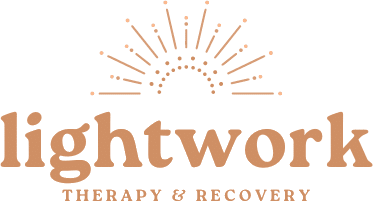Anxiety Treatment Program at Lightwork Therapy & Recovery
What is Anxiety?
Anxiety is a natural and often healthy emotion characterized by feelings of tension, worried thoughts, and physical changes like increased blood pressure. However, when these feelings become excessive, lasting longer and affecting daily life, they might be classified as an anxiety disorder.
How Anxiety Develops: Risk Factors
Anxiety disorders develop from a complex set of risk factors, including:
- Genetics: Family history of anxiety or other mental health disorders.
- Brain Chemistry: Imbalances in neurotransmitters can contribute to anxiety.
- Personality: Certain personality types are more prone to anxiety disorders.
- Life Events: Traumatic or stressful events can trigger anxiety disorders.
- Medical Factors: Chronic medical conditions or medication side effects may lead to anxiety.
- Substance Abuse: Drugs or alcohol can exacerbate anxiety.
Statistics Surrounding Anxiety in the United States
The prevalence of anxiety disorder treatment is easy to understand once you realize 40 million adults suffer from anxiety disorders (ADAA). Unfortunately, only 36.9% of those suffering actually receive treatment. Other statistics regarding anxiety include the following:
- PTSD affects 7.7 million American adults and women are five times more likely to suffer from PTSD than men.
- General anxiety disorder affects roughly 3.1% of American adults and women are twice as likely to suffer from GAD than men.
- Specific phobias affect 19.3 million American adults and women are also twice as likely to suffer from phobias than men.

Different Types of Anxiety Disorders
Generalized Anxiety Disorder (GAD)
What It Is: GAD is characterized by persistent and excessive worry about various things, such as health, family, money, or work. The worry is often unrealistic or out of proportion to the situation.
Symptoms: Restlessness, fatigue, irritability, muscle tension, sleep disturbances, and difficulty concentrating.
Treatment: Treatment typically includes therapy, such as Cognitive-Behavioral Therapy (CBT, and medications like SSRIs or Benzodiazepines.
Panic Disorder
What It Is: Panic disorder involves recurring and unexpected panic attacks. These attacks are sudden periods of intense fear that may include palpitations, sweating, trembling, or feelings of impending doom.
Symptoms: Sudden, repeated attacks of fear, feelings of being out of control during a panic attack, and intense worries about the next attack.
Treatment: Therapy, especially cognitive behavioral therapy, medications, and sometimes lifestyle changes can be highly effective in managing panic disorder.
Social Anxiety Disorder
What It Is: Social Anxiety Disorder is a chronic mental health condition in which social interactions cause irrational anxiety, fear, self-consciousness, and embarrassment.
Symptoms: Intense fear of interacting with strangers, fear of physical symptoms that may cause embarrassment, avoidance of social situations.
Treatment: Individual and group therapy, medications like SSRIs, and skill-building to improve social interactions.
Specific Phobias
What It Is: Specific phobias are intense fears of particular objects or situations that pose little or no actual danger but provoke anxiety and avoidance.
Symptoms: Irrational fears and avoidance of specific objects or situations, such as flying, heights, or certain animals.
Treatment: Exposure therapy is commonly used, gradually exposing the patient to the feared object or situation in a controlled environment.
Obsessive-Compulsive Disorder (OCD)
What It Is: OCD is characterized by persistent, unwanted thoughts (obsessions) and irrational, excessive urges to do certain actions (compulsions).
Symptoms: Obsessions (repeated, persistent, and unwanted urges) and compulsions (repetitive behaviors).
Treatment: Therapy, especially CBT, and medications like SSRIs can be helpful in treating OCD.
Post-Traumatic Stress Disorder (PTSD)
What It Is: PTSD is a mental health condition triggered by a terrifying event, either experiencing it or witnessing it.
Symptoms: Flashbacks, nightmares, severe anxiety, uncontrollable thoughts about the event.
Treatment: Treatment may include various types of psychotherapy as well as medications to manage symptoms.
Treatment for Anxiety
Anxiety treatment programs are typically developed uniquely to each person’s own signs and symptoms. Anxiety treatment programs typically include a blend of ongoing therapy and medication.
Treatment Programs
For clients facing the complex challenges of anxiety, entering a treatment program can be a critical step toward recovery.
Treatment programs are specifically designed to provide comprehensive support and care tailored to the individual’s needs. Intensive outpatient programs offer more rigorous and structured therapy, providing a higher level of care for those who require daily support. It may include group sessions, family therapy, and other intensive support methods.
On the other hand, outpatient programs offer more flexible therapy options to accommodate daily life, making it suitable for those who need professional care while still maintaining their work, school, or family commitments. These programs typically include regular appointments with mental health professionals and may also include attending support groups.
Therapy Options
Individual Therapy provides one-on-one sessions with therapists, allowing for personal attention and a therapeutic relationship that can delve deeply into underlying issues and triggers. This personalized approach is instrumental in understanding and managing anxiety disorders.
Group Therapy involves supportive group settings where individuals can share experiences, learn from others, and practice social skills in a safe and controlled environment. It fosters a sense of community and shared experience, often making it a vital part of recovery.
ACT or Acceptance and Commitment Therapy is an acceptance-based approach that encourages clients to embrace their thoughts and feelings rather than fighting or feeling guilty for them. It is often used to teach mindfulness skills and help people with anxiety to live in alignment with their values.
Holistic therapy focuses on mind-body connections, incorporating techniques like meditation, yoga, and nutritional guidance. By emphasizing overall well-being, holistic therapy can aid in managing anxiety by nurturing both physical and mental health.
Medications
Medications play an essential role in treating anxiety, particularly in conjunction with therapy. Benzodiazepines are commonly used for short-term anxiety relief, as they can quickly reduce symptoms. They are typically prescribed for acute anxiety or panic attacks.
Antidepressants, such as Selective Serotonin Reuptake Inhibitors (SSRIs), are commonly prescribed for anxiety disorders. They work by affecting neurotransmitters in the brain and can help reduce anxiety and depression symptoms over time.
Buspirone is a non-benzodiazepine medication used for chronic anxiety. Unlike benzodiazepines, it’s not habit-forming and may be prescribed for long-term treatment.
References
https://adaa.org/understanding-anxiety
https://adaa.org/understanding-anxiety/facts-statistics
https://www.nimh.nih.gov/health/statistics/generalized-anxiety-disorder
https://www.nimh.nih.gov/health/statistics/panic-disorder
https://www.nimh.nih.gov/health/statistics/social-anxiety-disorder
https://www.nimh.nih.gov/health/statistics/specific-phobia
https://www.nimh.nih.gov/health/statistics/post-traumatic-stress-disorder-ptsd

